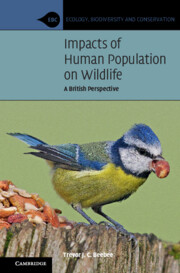Book contents
- Impacts of Human Population on Wildlife
- Ecology, Biodiversity and Conservation
- Impacts of Human Population on Wildlife
- Copyright page
- Dedication
- Contents
- Preface
- Acknowledgements
- Abbreviations
- 1 Population Matters
- 2 The State of British Wildlife
- 3 Human Activities Directly Killing Wildlife
- 4 Impacts of Development on Wildlife Declines
- 5 Impacts of Farming and Forestry on Wildlife Declines
- 6 Climate Change, Disease and Disturbance
- 7 The Human Population and Wildlife in Britain and Western Europe
- 8 Public Perceptions of Wildlife and Population Issues
- 9 International Aspects of Population Growth
- 10 Conservation in a Crowded Country
- References
- Index
6 - Climate Change, Disease and Disturbance
Published online by Cambridge University Press: 09 June 2022
- Impacts of Human Population on Wildlife
- Ecology, Biodiversity and Conservation
- Impacts of Human Population on Wildlife
- Copyright page
- Dedication
- Contents
- Preface
- Acknowledgements
- Abbreviations
- 1 Population Matters
- 2 The State of British Wildlife
- 3 Human Activities Directly Killing Wildlife
- 4 Impacts of Development on Wildlife Declines
- 5 Impacts of Farming and Forestry on Wildlife Declines
- 6 Climate Change, Disease and Disturbance
- 7 The Human Population and Wildlife in Britain and Western Europe
- 8 Public Perceptions of Wildlife and Population Issues
- 9 International Aspects of Population Growth
- 10 Conservation in a Crowded Country
- References
- Index
Summary
Three factors also related to impacts on wildlife are climate change, disease and disturbance. The UK has warmed significantly in recent decades, particularly in winter. This is having two main consequences for wildlife. Many plants and animals that reproduce in spring are doing so ever earlier. This phenological change has the potential to disturb food webs, although this does not yet seem to have happened to any significant extent. However, a second consequence, changes in species distributions, has certainly occurred. Many plants and animals have expanded northwards in Britain, and some newcomers have arrived from mainland Europe. On the downside, high alpine plants have declined and some seabirds have suffered from warming-related faunal changes in surrounding seas. Disease is a second factor that has caused some major species declines, including viral infections of rabbits and amphibians, as well as fungal mortality in trees. Finally, excessive disturbance by human footfall has generated environmental damage and at least local declines of sensitive species. This factor clearly relates to human numbers, but climate change is also influenced by the number of people on the planet as a whole.
- Type
- Chapter
- Information
- Impacts of Human Population on WildlifeA British Perspective, pp. 125 - 152Publisher: Cambridge University PressPrint publication year: 2022



